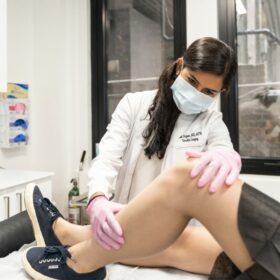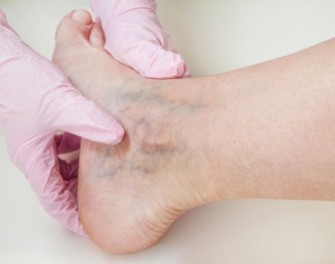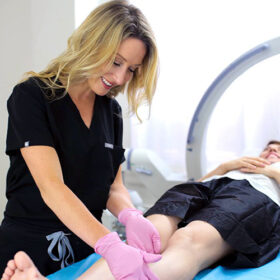If you are experiencing pain, swelling, or discomfort in your legs, it could be a sign of venous reflux, a condition where the valves in your leg veins fail to function properly, leading to blood pooling in the veins. This can cause varicose veins, spider veins, or even deep vein thrombosis (DVT), a blood clot in a deep vein. If left untreated, venous reflux can lead to chronic venous insufficiency (CVI), a more severe condition that can cause skin ulcers, bleeding, and other complications.
At Vein Treatment Clinic, we offer minimally invasive procedures to treat venous reflux, such as sclerotherapy, endovenous laser ablation, radiofrequency ablation, VenaSeal, ClariVein, and ambulatory phlebectomy. But what is the best treatment for venous reflux? Let’s take a closer look at some of the options available.
Diagnosis
Duplex ultrasound is a non-invasive imaging technique that uses high-frequency sound waves to produce detailed images of the veins and blood flow in the legs. During the procedure, a trained technician or physician applies a gel to the skin over the affected area and uses a transducer to emit sound waves. The sound waves bounce off the veins and are detected by the transducer, which converts them into visual images on a monitor.
The duplex ultrasound can differentiate between arterial and venous blood flow and can identify any areas of reflux, obstruction, or blood clots in the leg veins. This information is essential in determining the root cause of venous reflux and developing a personalized treatment plan.
Sclerotherapy
Sclerotherapy works by causing a controlled injury to the inner lining of the affected vein. During the procedure, a solution called a sclerosant is injected into the vein using a small needle. The sclerosant irritates the inner lining of the vein, causing it to collapse and stick together. Over time, the body absorbs the damaged vein and reroutes blood flow to healthier veins in the leg. Sclerotherapy is most effective for spider veins and smaller varicose veins that are close to the surface of the skin. The procedure is minimally invasive and does not require anesthesia, making it a safe and effective option for many patients.
Endovenous Laser Ablation (EVLA)
Endovenous laser ablation (EVLA) works by using heat energy from a laser to close the affected vein. During the procedure, a thin laser fiber is inserted into the vein through a small incision. Once inside the vein, the laser fiber emits energy, which heats and damages the vein wall. This causes the vein to collapse and seal shut, preventing blood from flowing through it. Over time, the body absorbs the damaged vein and reroutes blood flow to healthier veins in the leg. EVLA is most effective for larger varicose veins that are not suitable for sclerotherapy.
Radiofrequency Ablation (RFA)
Radiofrequency ablation (RFA) works by using heat energy from radiofrequency waves to close the affected vein. During the procedure, a thin catheter is inserted into the vein through a small incision. The catheter delivers radiofrequency energy to the vein wall, causing it to heat up and collapse. The vein is then sealed shut, preventing blood from flowing through it. Over time, the body absorbs the damaged vein and reroutes blood flow to healthier veins in the leg. RFA is also effective for larger varicose veins that are not suitable for sclerotherapy. The procedure is minimally invasive and typically performed in a vein clinic.
VenaSeal
VenaSeal is a minimally invasive procedure that uses a medical adhesive to close the affected vein. During the procedure, a small catheter is inserted into the vein through a small incision. Ultrasound guidance is used to position the catheter in the affected area of the vein. Once in place, the catheter delivers a medical adhesive to the inner lining of the vein. The adhesive causes the vein to collapse and seal shut, preventing blood from flowing through it. Over time, the body absorbs the damaged vein and reroutes blood flow to healthier veins in the leg. VenaSeal is effective for larger varicose veins and is a safe and effective treatment option.
ClariVein
ClariVein is a minimally invasive procedure that combines mechanical agitation and a sclerosant solution to close the affected vein. During the procedure, a small catheter is inserted into the vein through a small incision. The catheter contains a rotating wire, which agitates the inner lining of the vein while delivering a sclerosant solution. The sclerosant solution causes the vein to collapse and stick together, preventing blood from flowing through it. Over time, the body absorbs the damaged vein and reroutes blood flow to healthier veins in the leg. ClariVein is effective for larger varicose veins.
Ambulatory Phlebectomy
Ambulatory phlebectomy is a minimally invasive surgical procedure that involves the removal of the affected vein through small incisions in the skin. During the procedure, a vein doctor makes tiny incisions in the skin and uses a specialized tool to remove the damaged vein in small sections. The surrounding healthy tissue is left untouched, and the incisions are closed with tiny stitches or adhesive strips. Ambulatory phlebectomy is most effective for larger varicose veins that are too large to be treated with sclerotherapy or endovenous procedures. The procedure is performed under local anesthesia and allows patients to return to normal activities immediately.
Compression Stockings
Compression stockings are a non-invasive treatment option for venous reflux that involves wearing specialized stockings that apply pressure to the leg. The pressure helps to improve circulation, reduce swelling, and alleviate symptoms such as pain, cramping, and fatigue. Compression stockings can also prevent the condition from worsening and the formation of blood clots in the leg. However, it’s important to note that compression stockings cannot treat underlying vein disease, and they are not a substitute for professional medical treatment.
Visit Your Nearest Vein Treatment Clinic – We Offer Hassle-free Insurance Verification!
If you are experiencing symptoms of venous reflux, it’s important to seek professional medical treatment to prevent the condition from worsening and reduce the risk of complications. At Vein Treatment Clinic, we offer state-of-the-art locations across the United States, including New York, New Jersey, Long Island, California, and Washington DC. We also offer hassle-free insurance verification even before your first appointment, so you can focus on getting the care you need without worrying about the financial aspect. Contact us today to schedule a consultation at your nearest vein clinic.











